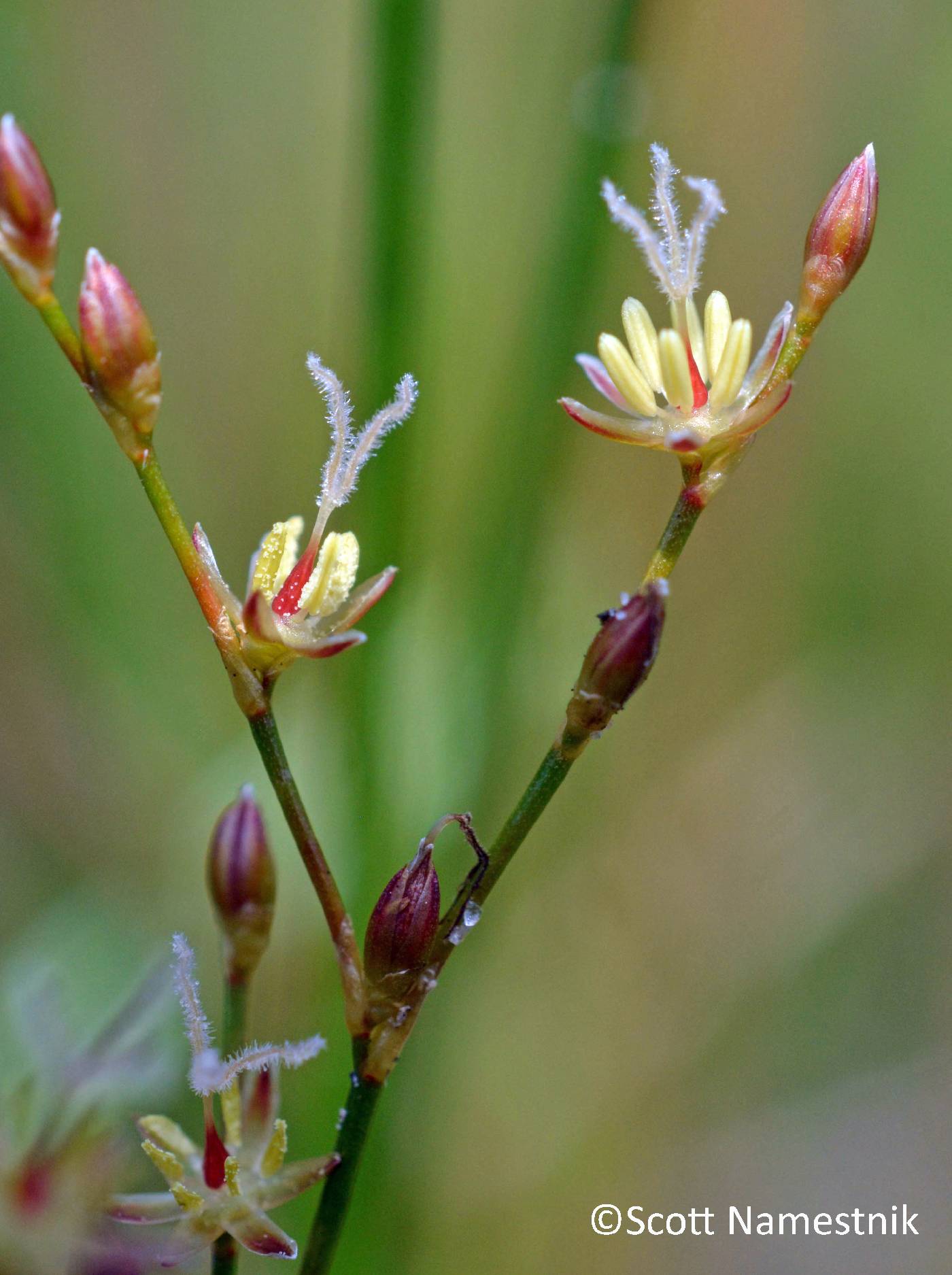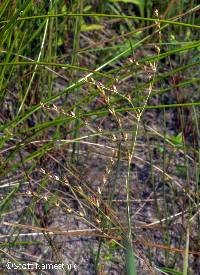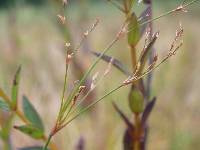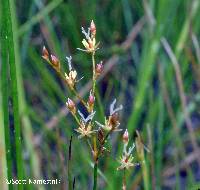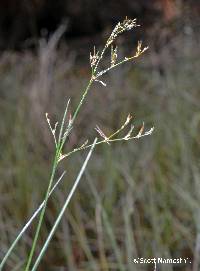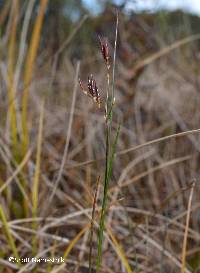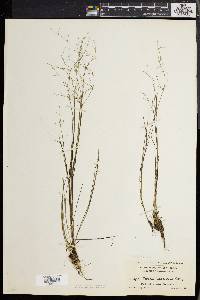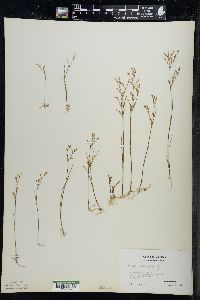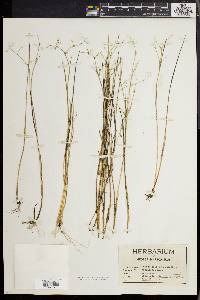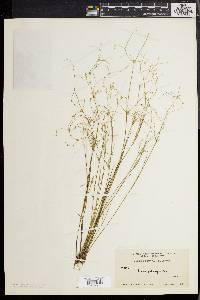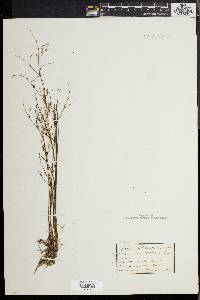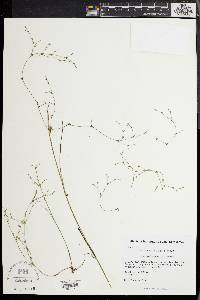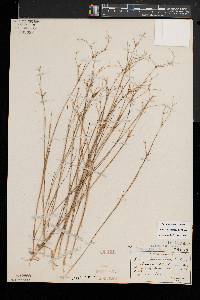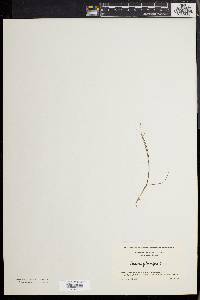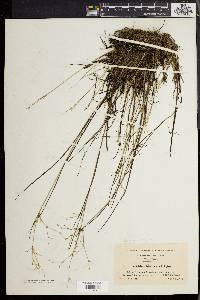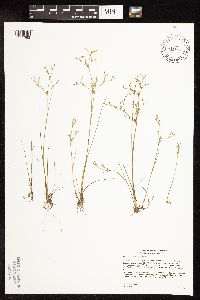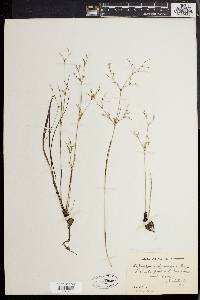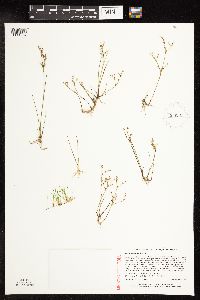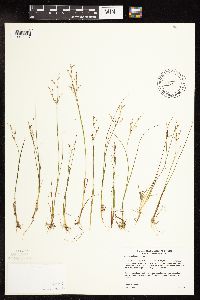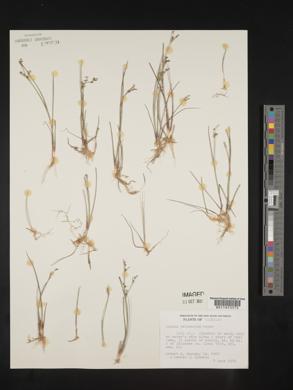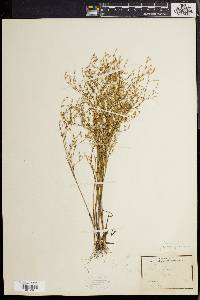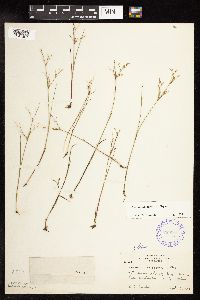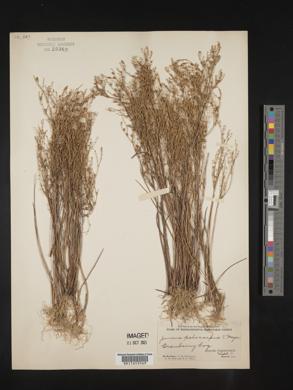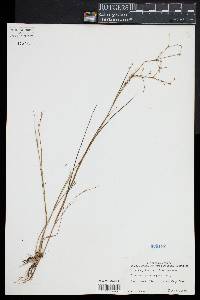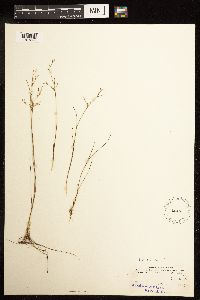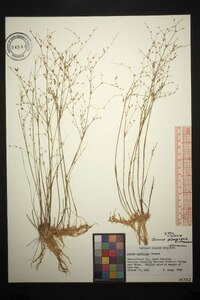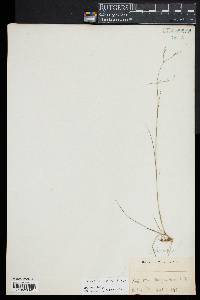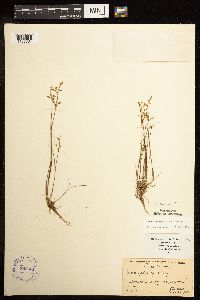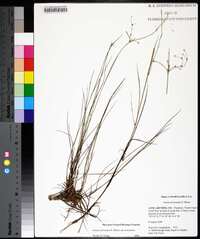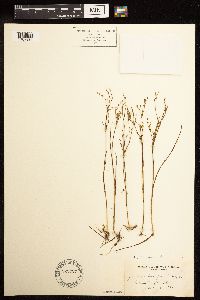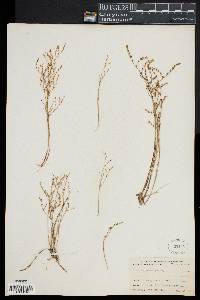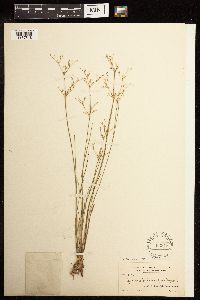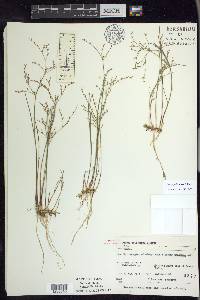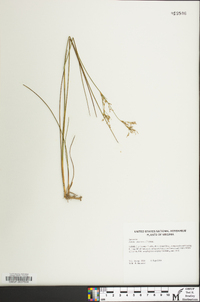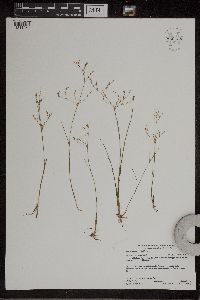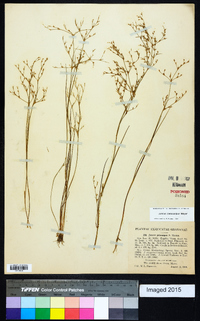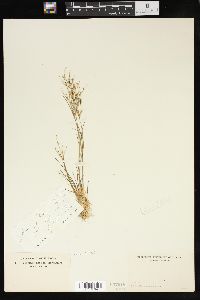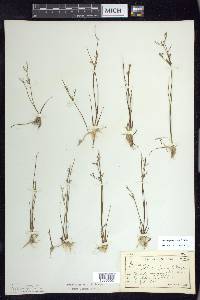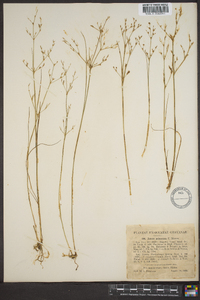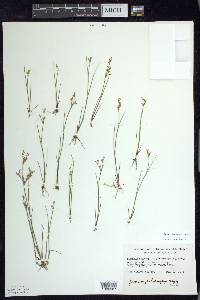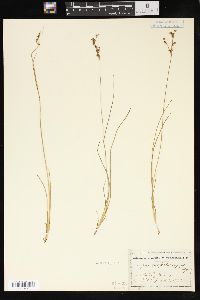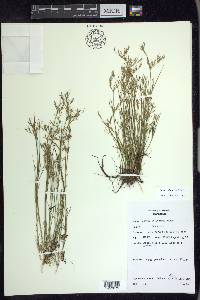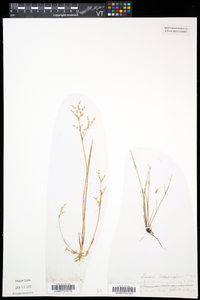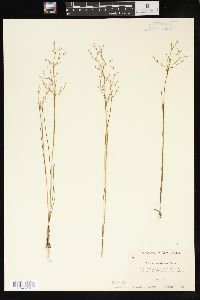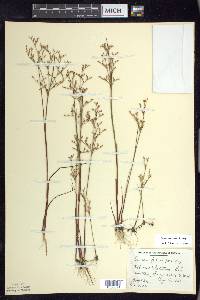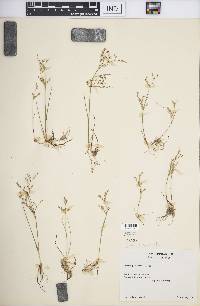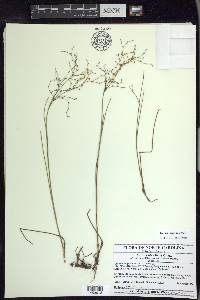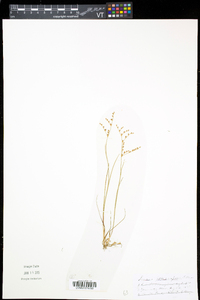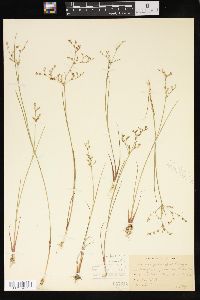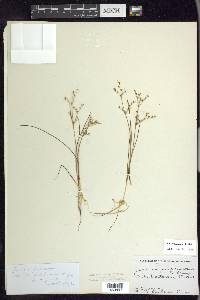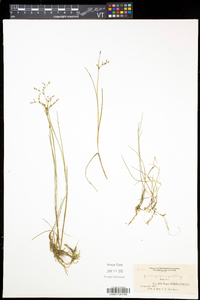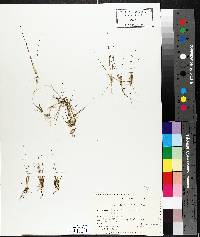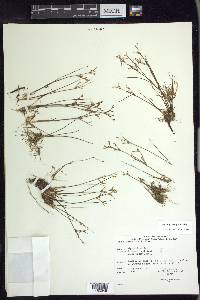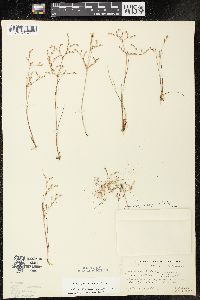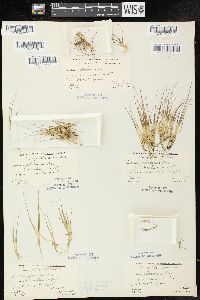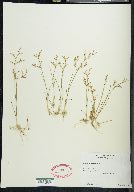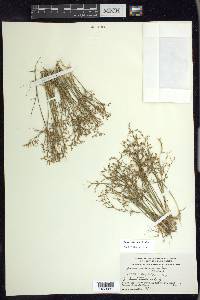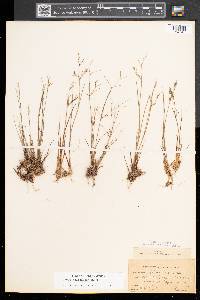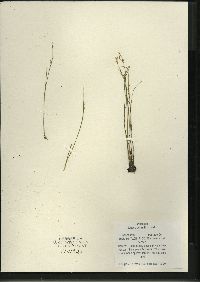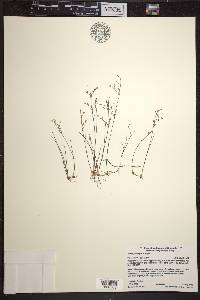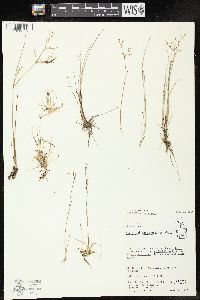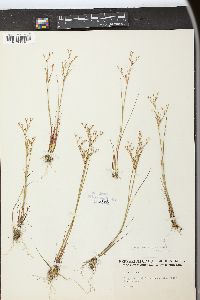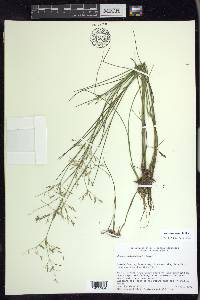
|
|
|
|
Family: Juncaceae
Brown-Fruit Rush
[Juncus conradii, moreJuncus pelocarpus f. submersus Fassett] |
Herbs, perennial, rhizomatous, 0.3--7 dm. Rhizomes 1--3 mm diam., nodes not swollen. Culms erect, terete, 1--2 mm diam., smooth. Cataphylls 0 (rarely 1, straw-colored, apex obtuse). Leaves: basal 0--2, cauline 1--4, small fascicles of short capillary leaves often on rhizomes and stems; auricles 0.3--1 mm, apex rounded, membranaceous; blade terete, 1.5--11 cm x 0.8--1.1 mm. Inflorescences terminal cymes, flowers single or paired at nodes, (rarely in 3s), 2--25 cm, branches spreading to erect; primary bract erect. Flowers: tepals straw-colored, oblong; outer tepals 1.6--2.3 mm, apex obtuse; inner tepals 1.8--2.8 mm, apex obtuse; stamens 6, anthers 2--3 times filament length. Capsules included to exserted, chestnut brown, 1-locular, narrowly ovoid, 1.5--3.5 mm, apex acute proximal to beak, valves separating at dehiscence, fertile only proximal to middle. Seeds ovoid, 0.3--0.5 mm, not tailed; body clear yellow-brown. 2n = 40. Fruiting late summer--fall. Shores, peat bogs, sandy soils, pools, occasionally submersed in lakes, rarely in salt water; 0--600 m; B.C., N.B., Nfld. and Labr. (Nfld.), N.S., Ont., P.E.I., Que.; Ala., Conn., Del., D.C., Fla., Ga., Ind., Maine, Md., Mass., Mich., Minn., N.H., N.J., N.Y., N.C., Ohio, Pa., R.I., S.C., Vt., Va., Wis. Populations from Virginia and south have been separated as Juncus pelocarpus var. crassicaudex (J. abortivus) based on their taller culms and thicker rhizomes. The evidence used to support the varietal status for the southeastern plants (N. A. Murray and D. M. Johnson 1987) clearly demonstrates that these plants are the southern end of a cline. The flowers are often replaced by bulbils.
Perennial grasslike forb 3 - 70 cm tall Leaves: none to two basal and one to four alternate on stem, 1.5 - 11 cm long, 0.8 - 1.1 mm diameter, slender, grasslike, round in cross section, and with obscure crosswise partitions inside (septate). The leaves also have a membranous, basal, 0.3 - 1 mm long, round-tipped, ear-like appendage (auricle) at the top of the leaf sheath. Inflorescence: a terminal, 2 - 25 cm long, somewhat broad, often flat-topped, many-branched structure with ascending or widely spreading branches with small, single or paired (rarely three), radially symmetric flowers at each node. Often the flowers are replaced by tiny, vegetative, bud-like organs called bulbils. Stamens: six, with very long anthers, which are two to three times longer than the filaments. Pistil: with one superior ovary, and three stigmas. Fruit: single-chambered, chestnut-brown, shorter or very slightly taller than tepals (1.5 - 3.5 mm), narrowly egg-shaped, pointed-tipped capsules, which open down the sides. Stems: erect, smooth, round in cross section, 1 - 2 mm diameter, and arising from 1 - 3 mm diameter rhizomes lacking swollen nodes. Seeds: many, clear yellow-brown, 0.3 - 0.5 mm long, egg-shaped with short-pointed or abruptly narrowed tips, but without distinct narrowed tails at the ends. Tepals: six in two whorls of three, straw-colored, oblong, blunt-tipped. While the two ranks of tepals are very similar lengths, the outer three tepals are slightly shorter (1.6 - 2.3 mm) than the inner three tepals (1.8 - 2.8 mm). Similar species: Juncus pelocarpus is unique in the subgenus Septati because it only has one or two flowers per node rather than a compact cluster of flower heads. Other distinguishing characters are the blunt tepal apices, the anthers being much longer than the filaments, and the leaves having only obscure cross partitions (septa). Other species of Juncus (in the subgenera Poiophylli and Genuini) that have single flowers normally also have small bracts (bracteoles) just below each flower. In addition to possessing bracteoles, most members of the subgenus Poiophylli, such as J. anthelatus, J. dudleyi, J. interior, or J. tenuis, also differ by having flat leaves that lack cross partitions (septa), and the capsules rarely have pointed beaks. Members of the subgenus Genuini (J. effusus and J. balticus var. littoralis) are further easily distinguished since there are no stem leaves, and their inflorescences appear to spring out from the side of the stem (lateral) rather than terminating the stem. Flowering: July to September Habitat and ecology: Rare, localized to the eastern Chicago Region in Indiana and Michigan, in shallow water or sandy moist ground, and along sandy or mucky shores. Occurence in the Chicago region: native Etymology: Juncus is the classical name for Rush. Pelocarpus means "fruit of the mud". Author: The Field Museum Rhizomatous, colonial, ±erect, mostly 1-5 dm, with very slender, obscurely septate lvs; infl much branched, 5-15 cm, broadly ovoid or obpyramidal with ascending branches to flattened with divaricate branches, bearing numerous solitary or paired, distinctly secund fls, some or all of the fls usually replaced by subulate bulbils; fls eprophyllate; tep oblong, scarious on the margins and at the obtuse tip, the sep 1.6-2.3 mm, the pet 1.8-2.8 mm; anthers 6, longer than the filaments; fr narrowly ovoid-ellipsoid, 2.4-3.1 mm, gradually acuminate into a slender beak, unilocular, the placentae fertile only below the middle; seeds few, plump, 0.4 mm; 2n=40. Moist boggy or sandy soil and shores, in soft-water habitats with a seasonably variable water-level. Var. pelocarpus, ranging from Lab., Nf. and Que. to Minn., s. to Del., Md., and n. Ind., is dwarf, mostly 1-3 dm, erect or prostrate (but not repent), the rhizome 1 mm thick or less. The ill-defined clinal var. crassicaudex Engelm. (J. abortivus), occurring irregularly from se. Va. to Fla., is stouter, 3-8 dm, erect, the rhizome 2-5 mm thick. Gleason, Henry A. & Cronquist, Arthur J. 1991. Manual of vascular plants of northeastern United States and adjacent Canada. lxxv + 910 pp. ©The New York Botanical Garden. All rights reserved. Used by permission. From Flora of Indiana (1940) by Charles C. Deam Fairly common in the northwestern counties, mostly in the dune area. A species of wet open habitats, occurring on sandy or mucky borders of ponds, lakes, and swamps and in sloughs and swales. The more diffuse proliferous plants are often entirely sterile. …… Indiana Coefficient of Conservatism: C = 10 Wetland Indicator Status: OBL |

